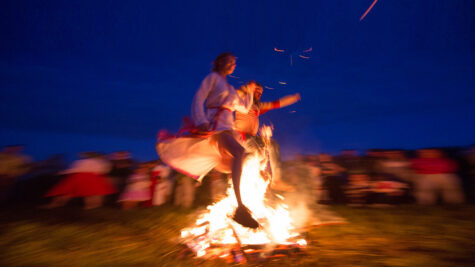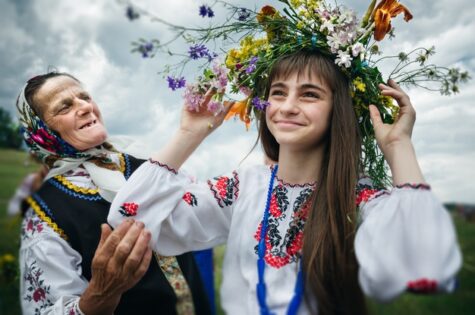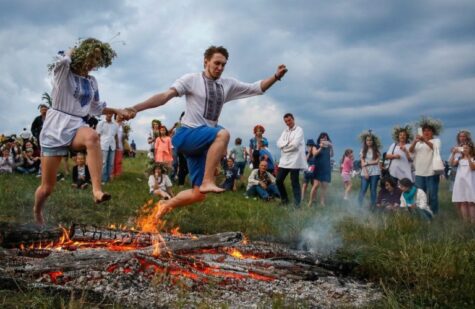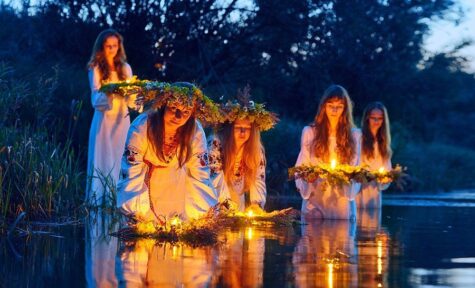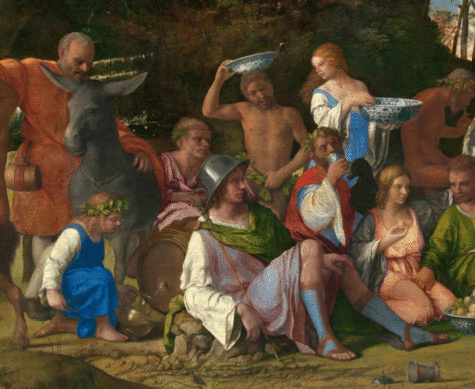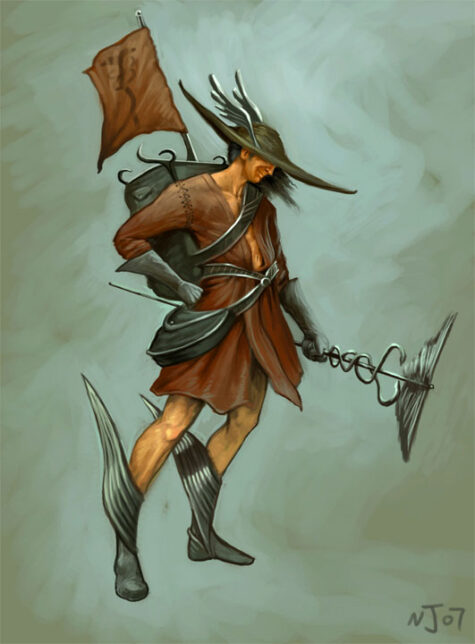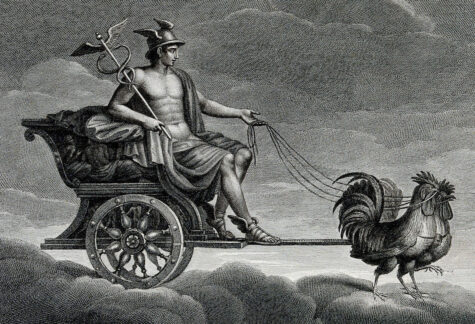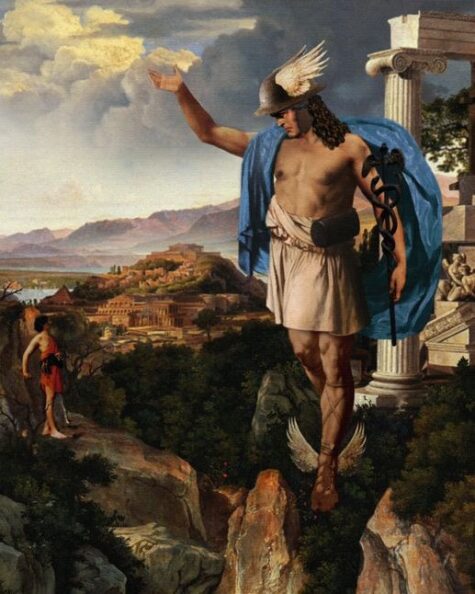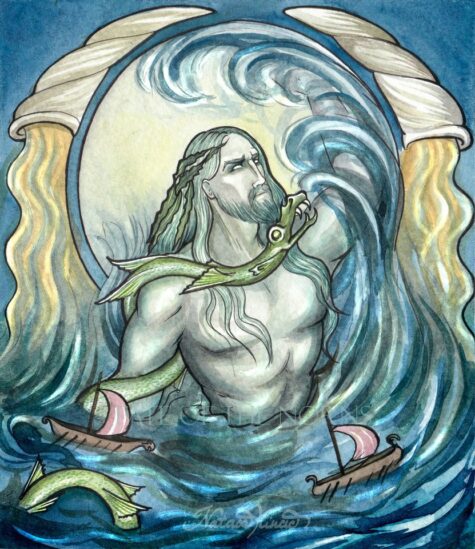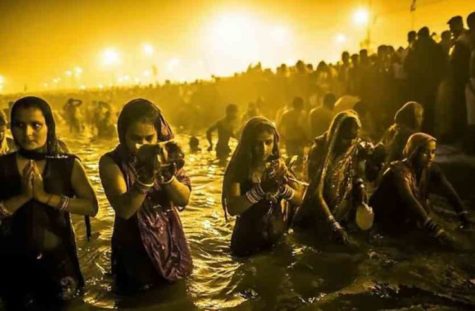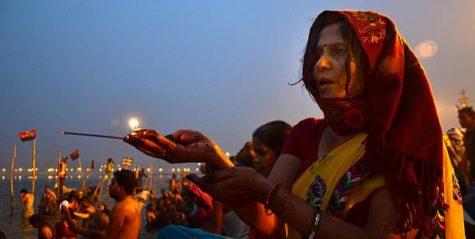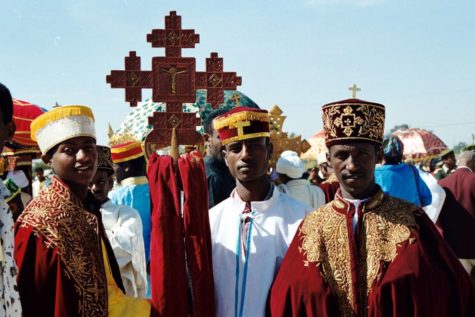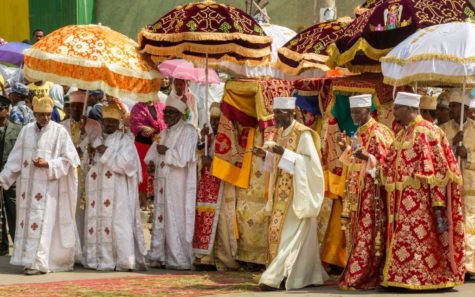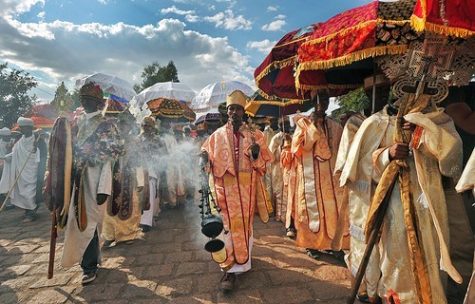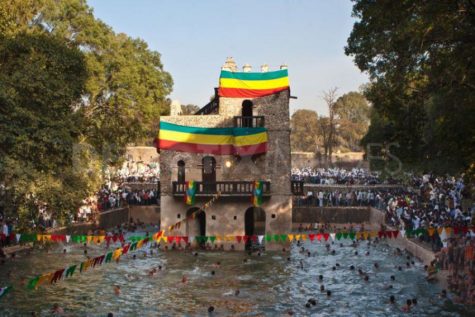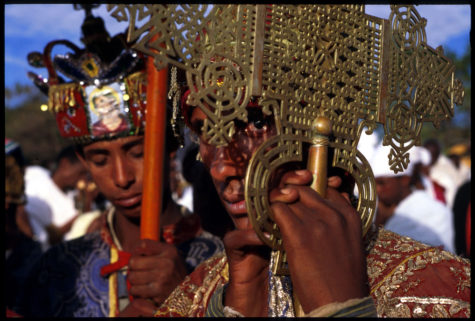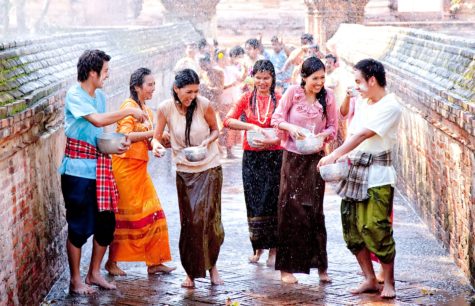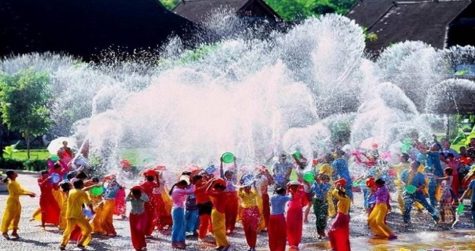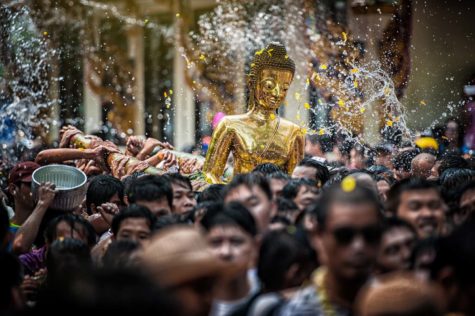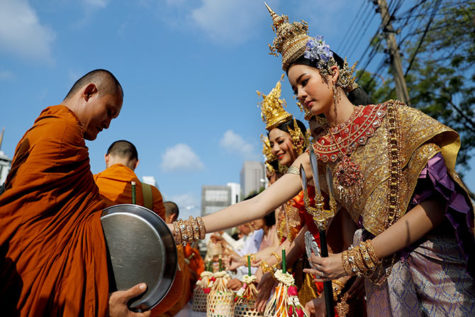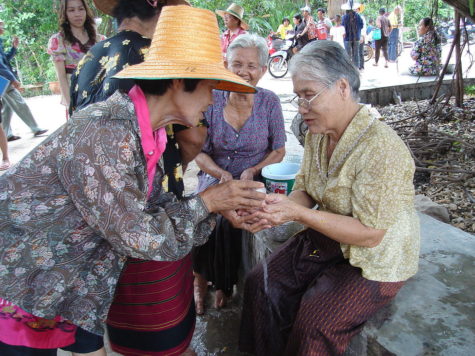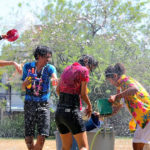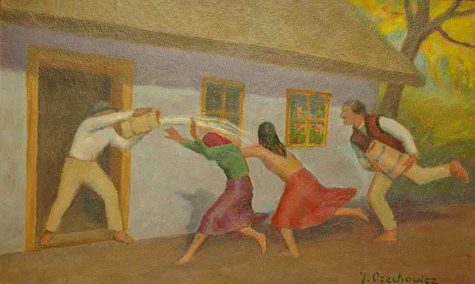Water
According to Tibetan and Vedic astrology, there are a cluster of stars, called the ‘Rishi’ stars, that ‘appear’ for one week each year – usually during the 8th lunar month (September). According to Tibetan astrology, the Rishi stars will be ‘out’ this year from Sept. 9-15. In Tibetan this is known as ‘Karma Rishi.’
According to Hindu legend, these stars were once great sages of the past, who, upon their death, ascended up into the heavens and became these stars. When they are visible in the night sky, their light is said to possess special healing powers that transform all water into a healing nectar.
Some sources state these stars are the Ursa Major, or the ‘big dipper,’ also known as the Sapta Rishi stars, who are associated with the seven great Rishis of Vedic lore. Other sources say this is the Canopus star, which is associated with the Rishi Agastya, and is said to be the ‘cleanser of waters.’
Typically, Tibetan doctors and healers would place buckets of water outside during this time, then use this water for making their medicines. Lama Dawa remembers how His Holiness Matrul Rinpcoche – a great Tibetan physician – would then boil this water down, thus concentrating it, then use this water to make the herbal medicinal pills, and also to consecrate the water with healing mantras.
Another way of benefiting from this healing water is to bathe in pools, ponds or rivers during this time. Or, collect water in buckets and use that for bathing. Any water – whether it is ocean, river, stream, or water in pools, is imbued with the healing qualities of the stars.
This water can be used to make healing tinctures, or for giving to pets and plants. Even the water in our own bodies can be ‘blessed’ and purified by this special healing energy by exposing your body to the night sky when the stars are out.
It is a particularly auspicious time to do practices such as the Vajra Armor mantra, which is used to consecrate water, or Medicine Buddha mantras and offering pujas.
Prayer:
Rangrig Dorje Rinpoche offers this prayer and mantra to be said while taking a bath outside under these stars:
༈ཇི་ལྟར་བལྟམས་པ་ཙམ་གྱིས་ནི། ལྷ་རྣམས་ཀྱིས་ནི་ཁྲུས་གསོལ་ལྟར།
JI-TAR TAM-PA TSAM-GYI NI / LHA-NAM KYI-NI TRU-SOL TAR /
ལྷ་ཡི་ཆུ་ནི་དག་པ་ཡིས། དེ་བཞིན་བདག་གིས་ཁྲུས་བགྱིའོ།
LHA-YI CHU-NI DAG-PA YI / DE-ZHIN DAG-GI TRU-GYI O /
- Mantra:
ཨོཾ་སརྦ་ཏ་ཐཱ་ག་ཏ་ཨ་བྷི་ཥེ་ཀ་ཏ་ས་མ་ཡ་ཤྲཱི་ཡེ་ཧཱུྃ༔
OM SARWA TAT’HAGATA ABHISHEKA TA SAMAYA SHRI YE HUNG
- Aspiration:
འདི་ནི་ཁྲུས་མཆོག་དཔལ་དང་ལྡན། ཐུགས་རྗེའི་ཆུ་ནི་བླ་ན་མེད།
DI-NI TRU-CHOG PAL-DANG DEN / T’HUG-JE’I CHU-NI LA-NA MED /
བྱིན་རླབས་ཡེ་ཤེས་ཆུ་ཡིས་ནི། ཅི་འདོད་དངོས་གྲུབ་སྩོལ་བར་མཛོད།
JIN-LAB YE-SHE CHU-YI NI / CHI-DOD NGO-DRUB TSAL-WAR DZOD
Western Astrology:
Western astrologer, Terry Nazon, offered this information about the Sapta Rishi Stars:
“They are the fixed stars of Ursa Major the Big Dipper. They are always visible…but during that time in September as the constellation late Leo and early Virgo is right above us in the night sky…they are closest then and right above us.
Because the earth is moving and just like the moon moves across the night sky so will the big dipper…it can also be that the Sun is activating them…for planets and stars to be effective they have to be triggered by a planet or star like the sun.
If you are “charging” water you will want to place the water where it receives the most exposure. For instance maybe there’s tree blocking the Big Dipper in your front yard…and remember, we are made up of 60 % water and in ancient Kabbalah, the text said to bath ourselves in this planetary “rain” they called it.”
The Rishi stars:
- 1. Dubhe The Bear:
Astrology, arrogance, psychic power, destruction; aka Krathu, one of the 7 Rishis (Hindu sages) in Ursa Major; Bast Isis, the Egyptian goddess; “The Eye”; “Heaven’s Pivot”
- 2. Merak:
Prudent, restrained, mistrustful, self-controlled (but angry when roused), love of command, power to achieve, good with animals; Pulaha, one of the 7 Rishis (Hindu sages) of Ursa Major
- 3. Phecda:
Civilising influence, tamer of beasts, transmission of divine knowledge; Pulasthya, one of the 7 Rishis (Hindu sages) of the Great Bear, Ursa Major; bloodbaths, assassinations, riots, sexual perversion
- 4. Tania Borealis:
In the right hind paw of Ursa Major, along with Tania Australis, this star was part of an early Arabian constellation, The Gazelle, of which this group is the “Second Leap”. The Great Bear is mainly martial in action, considered unfortunate for nations and kings.
- 5. Megrez:
Spiritual sight; creativity; violence; Atri, one of the 7 Rishis (Hindu sages), the ruling star of the Great Bear, Ursa Major
- 6. Alioth, The Black Horse:
Suicide among women; danger in pregnancy; Angirasa, one of the 7 Rishis (Hindu sages) in Ursa Major
- 7. Mizar:
Connected with fires of a catastrophic extent and mass calamities; Vasishta, one of the 7 Rishis (Hindu sages) of Ursa Major
- 8. Alula Borealis:
Hindmost foot of Ursa Major. As the northern Alula, it is more fortunate. Associated with female infidelity & revenge. The Great Bear gives a quiet, prudent, suspicious, mistrustful, self-controlled, patient nature, but an uneasy spirit; great anger when roused.
The Canopus Star:
The Canopus star is the second brightest star after Sirius. In Indian Vedic literature, the star Canopus, known as the ‘smiling star’ is associated with the sage Agastya, one of the ancient rishis (the others are associated with the stars of the Big Dipper). Agastya, the star, is said to be the ‘cleanser of waters’ and its rising coincides with the calming of the waters of the Indian Ocean.
Canopus is a bright star most easily visible in the Southern Hemisphere. It is in the constellation Carina, the keel. The star is of a fairly rare type, considered a class F giant on the main sequence of stars. This means it has a mass close to that of the sun.
Because the star’s spectral class is not well studied, it is difficult to establish how far away Canopus is. Parallax measurements with the Hipparcos satellite have established it to be about 313 light-years away.
Canopus can’t be seen from most locations in Europe and North America. Observers in northern latitudes south of 37°N can find the star below Sirius in the southern sky on winter evenings. Canopus is at its highest in February around 9 pm. It is located about 36 degrees to the south of Sirius.
In science fiction, Canopus is perhaps best known for being the parent star for Arrakis, a dusty desert planet in the “Dune” universe.
Canopus is used in space navigation to adjust the position of spacecraft in space. Many spacecraft are equipped with a special camera called the Canopus Star Tracker.
Sources:
Kupala Night and Ivan Kupala Day is celebrated in Ukraine, Poland, Belarus and Russia from the night of July 6 to the day of July 7 on the Gregorian calendar. This corresponds to June 23 to 24 on the traditional Julian calendar.
The celebration is linked with the summer solstice when nights are the shortest and includes a number of Slavic rituals. This holiday symbolizes the birth of the summer sun – Kupalo.
In the fourth century AD, this day was Christianized and proclaimed the holiday of the birth of John the Baptist. As a result, the pagan feast day “Kupala” was connected with the Christian “Ivan” (Russian for John) which is why the Ukrainian, Belarusian and Russian name of this holiday combines “Ivan” and Kupala which is derived from the Slavic word for bathing.
The two feasts could be connected by reinterpreting John’s baptizing people through full immersion in water. However, the tradition of Kupala predates Christianity. The pagan celebration was adapted and reestablished as one of the native Christian traditions intertwined with local folklore.
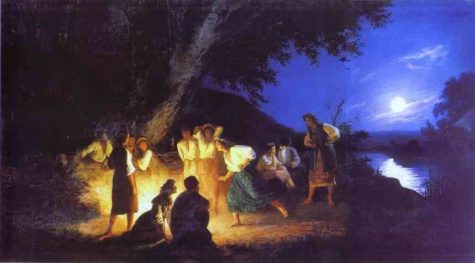
And Then It Was Banned
In the XVIII century, there were a number of documents testifying to the fierce struggle of the Church and secular authorities with the Kupala rite.
For example, in 1719 Hetman of Zaporizhzhia Army, Chairman of the Cossack state of the left bank of Ukraine, Ivan Skoropadskyi issued a decree “On parties, fisticuffs, gatherings on the holiday of Ivan Kupala etc.”, which granted the right to physically punish (tie up and beat with sticks) and excommunicate from the Church all participants of Kupala games.
In 1723, Przemysl Cathedral in Bereziv banned dancing and entertainment near the Kupala fire. In 1769, Catherine II issued a decree banning the holiday. And despite all the prohibitions, the pagan nature of folk rituals was strong. The church did not ban the holiday, but it did try to fill it with Christian content.
It is the pagan essence, mysticism, marriage-erotic motifs of Kupala rite that attracted the attention of many researchers and artists. Thanks to public ritual such art masterpieces as the Opera “Ivana Kupala” by S. Pysarevskyi; folklore work of L. Ukrainka “Kupala in Volyn”; the story of M. Gogol “Night of Ivan Kupala”; the film of Yurii Ilienko “Night on Ivan Kupala”; the Folk Opera of Y. Sankovych “When the fern blooms.” The latter during 40 years was banned and only in 2017 its world premiere took place on the stage of the Lviv Opera.
Kupala Today
At the beginning of the twentieth century Kupala rite gradually began to disappear. Today it exists in the “revived”, or rather “introduced” in Soviet times (during the anti-religious struggle) form of staged ceremony.
Although the magical meaning of rituals was leveled, and the celebration gained artistic value, the main pagan ritual actions have reached us – weaving of wreaths by girls and letting them into the water; honoring Kupala tree with dances; kindling the fire and jumping over the fire; ritual bathing; burning or sinking of trees; the burning of sacks of straw or stuffed dolls; the ceremonial dinner.
It is interesting that the name of the holiday, and the ritual fire, and decorated tree are called “Kupalo”, “Kupailo” or “Kupailytsia”. These are also the main elements of the rituals, which are based on the cult of fire, water and vegetation. Rituals symbolize the union of male (fire) and feminine (water) elements, were carried out with the aim of ensuring productivity, health, procreation.
On the territory of Ukraine for many centuries Kupala customs changed and they were not everywhere equally preserved. The majority were saved in Polissia as one of the more archaic zones of the Slavic world.
The holiday is still enthusiastically celebrated by the younger people of Eastern Europe. The night preceding the holiday (Tvorila night) is considered the night for “good humor” mischiefs (which sometimes would raise the concern of law enforcement agencies).
On Ivan Kupala day itself, children engage in water fights and perform pranks, mostly involving pouring water over people. Many of the rites related to this holiday are connected with the role of water in fertility and ritual purification.
According to ancient traditions, Ivan Kupala is the festival of the sun, and the most important role in mystical rites belongs to the power of fire. Our ancestors believed that the fire is the sun-embryo in the womb. Therefore, in the Kupala night taken to jump over the fire.
On Kupala day, young people jump over the flames of bonfires in a ritual test of bravery and faith. First, the oldest of the young men jumped over the fire.
For the highest jumpers it predicted a good harvest and prosperity for his family. Then pairs would jump, traditionally it would be a boy and a girl, but I assume that in some areas it’s permissible for pairs of any kind to take the jump together. If the couple is successful in their jump over the fire – they will certainly marry. The failure of a couple in love to complete the jump, while holding hands, is a sign of their destined separation. And anyone entering the flames during their jump can expect trouble
On the evening of July 6, unmarried girls take wreaths they have woven and throw them into the water. Unmarried men then try to grab the one belonging to the girl they are interested in. If you snag a wreath, the girl who made it will be expected to kiss you and the two of you will be paired up for the evening.
Girls may also float wreaths of flowers (often lit with candles) on rivers, in an attempt to gain foresight into their romantic relationships based from the flow patterns of the flowers on the river.
When the fun subsides, many people light candles from the hearth on pre-prepared wreath baskets and go to the river to put them on the water and thus honor their ancestors.
There is an ancient Kupala belief that the eve of Ivan Kupala is the only time of the year when ferns bloom. Prosperity, luck, discernment, and power befall whom ever finds a fern flower. Therefore, on that night, village folk roam through the forests in search of magical herbs, and especially, the elusive fern flower.
Traditionally, unmarried women, signified by the garlands in their hair, are the first to enter the forest. They are followed by young men. Therefore, the quest to find herbs and the fern flower may lead to the blooming of relationships between pairs within the forest.
It is to be noted, however, that ferns are not angiosperms (flowering plants), and instead reproduce by spores; they cannot flower.
In Gogol’s story The Eve of Ivan Kupala a young man finds the fantastical fern-flower, but is cursed by it. Gogol’s tale may have been the stimulus for Modest Mussorgsky to compose his tone poem Night on Bald Mountain, adapted by Yuri Ilyenko into a film of the same name.
Sources:
June 8th is World Oceans Day, a day to honor and protect the world’s oceans. We celebrate World Oceans Day to remind everyone of the major role the oceans have in everyday life. They are the lungs of our planet, providing most of the oxygen we breathe. It is the oceans which help to regulate our climate and ultimately are the source of all of our water, which is the reason we are able to exist.
Life emerges from salt water, both metaphorically speaking and literally Each person begins their Earthly incarnation swimming in their mother’s salty amniotic fluid. Ocean water is also used to signal rebirth in the next realm.
The purpose of the Day is to inform the public of the impact of human actions on the ocean, develop a worldwide movement of citizens for the ocean, and mobilize and unite the world’s population on a project for the sustainable management of the world’s oceans. They are a major source of food and medicines and a critical part of the biosphere. In the end, it is a day to celebrate together the beauty, the wealth and the promise of the ocean.
Clearly, today is sacred to all deities of water and seas including Mananan, Poseidon, Neptune, La Sirene, Aegir, Oceanus, Yemaya, Kanaloa, and Agoueh, amongst many many others.
If you are by the sea, take some time to walk the beach and pick up any rubbish that you find, especially plastics.
An Ocean Spirit Wishing Spell
Address your request to Aphrodite, Poseidon, Yemaya, Sirene, Aegir, Neptune, or any other ocean spirit you choose. The request should be addressed specifically to someone. Don’t send out a generic request. Write your request on rice paper, or some other biodegradable paper. Launch it into the waves and await your response.
Important Facts About The Ocean
Just knowing about World Oceans Day is not enough for your some people to be able to grasp the whole concept of how important the ocean is for human survival. To encourage others to celebrate our oceans and strive to make a difference, you could share some fun facts on World Oceans Day and how important the oceans are:
- 97% of Earth’s water is in the oceans, which is home to more than 200, 000 known species and millions of unidentified organisms.
- The oceans purify the air we breathe by absorbing 30% of the carbon dioxide in the air, which also helps in reducing the effects of global warming and climate change.
- Oceans are the world’s largest source of protein, and more than 2.6 billion people depend on the oceans as their primary source of protein.
- 40% of the oceans of the world are today affected by human actions causing pollution, depletion of fisheries, loss of coral reefs and endangerment of marine species. Seven out of the 13 great whale species are endangered today.
- 13, 000, 000 tons of plastic leak into the ocean water each year. It has been predicted that there will be more plastic than fish in the ocean by 2050. Over 100, 000 marine wildlife animals are killed each year due to plastic contamination of the oceans.
Sources:
Mercuralia is a Roman celebration known also as the “Festival of Mercury”. Mercury (Greek counterpart: Hermes) was the god of merchants and commerce. On May 15 merchants would sprinkle their heads, their ships and merchandise, and their businesses with water taken from the well at Porta Capena.
Some traditions celebrate the Mercuralia on May 4 because Mercury is the Roman incarnation of the Greek god Hermes. The sacred number of Hermes is four and it is said that his mother Maia gave birth to him on the fourth day of the month. The month of May is, of course, named after Maia.
About Mercury:
Mercury is a trickster spirit who is happy to masquerade as other spirits. Long ago the Italian deity Mercury was syncretized to Greek Hermes. The two are now virtually indistinguishable, but they are not the same spirit. Mercury is urban, while the roots of Hermes lie in the rustic countryside. Hermes has a a broader base of interests, while Mercury is a spirit of money, finances, and prosperity. His name is related to words like merchants, merchandise, or commerce as well as mercenary, a soldier of fortune.
Mercury is a generous spirit but his temperament is mercurial. He loves practical jokes and word games. Always be exceptionally careful how you phrase petitions to him, paying close attention to nuance and implication, lest he give you what you accidentally asked for, rather than what he knows very well that you desire.
Mercury has quicksilver intelligence and wit. He is easily bored. Keep him entertained and he’ll be more likely to keep you happy, healthy, and prosperous. Although Mercury patronizes the dishonest, he may also be invoked to protect against them.
Homeric Hymn to Hermes:
I sing about Hermes, the Cyllenian slayer of Argus, lord of Mt. Cyllene and Arcadia rich in flocks, the messenger of the gods and bringer of luck, whom Maia, the daughter of Atlas, bore, after uniting in love with Zeus.
She in her modesty shunned the company of the blessed gods and lived in a shadowy cave; here the son of Cronus used to make love to this nymph of the beautiful hair in the dark of night, without the knowledge of immortal gods and mortal humans, when sweet sleep held white-armed Hera fast.
But when the will of Zeus had been accomplished and her tenth month was fixed in the heavens, she brought forth to the light a child, and a remarkable thing was accomplished; for the child whom she bore was devious, winning in his cleverness, a robber, a driver of cattle, a guide of dreams, a spy in the night, a watcher at the door, who soon was about to manifest renowned deeds among the immortal gods.
Maia bore him on the fourth day of the month. He was born at dawn, by midday he was playing the lyre, and in the evening he stole the cattle of far-shooting Apollo.
So hail to you, son of Zeus and Maia. Hail, Hermes, guide and giver of grace and other good things.
Invocation to Hermes-Mercury-Tjehuti:
Hail to you, Hermes-Mercury-Tjehuti,
Fleet-footed Messenger of the Gods,
In all your many faces.
Come down from Mount Olympus,
Fly in from the mighty city of Roma,
Rise up from the land of Kemet,
Race across land and sea with your legendary speed,
And come join me this day!
As Hermes you are known as Argophontes,
The Psychopomp who guides souls to the Underworld,
Who, with your wand, bestows and banishes sleep and guides us through dreams,
You whose cleverness and oratory is unmatched,
With honeyed tongue and charm you ease your way through conflict,
Divine trickster extraordinaire,
Patron of learning and the sciences,
Patron of travelers on their journeys,
Of thieves and merchants,
Of wrestlers and magicians.
Ritual For The Mercuralia
The Greeks believed that the Egyptian god Tjehuti (Thoth) was also an incarnation/aspect of Hermes (or vice versa). This ritual honors the tri-form nature of this God by the name of Hermes-Mercury-Tjehuti.
I see Mercury as the most materially-oriented of the three aspects, focusing on business, commerce, and finances. I see Tjehuti as the most spiritually-oriented of the three aspects, focusing on wisdom, knowledge, abstract concepts, and the higher self. I see Hermes as a dynamic balance of the two, the aspect that binds them together.
For a ritual honoring and invoking Mercury, Hermes, and Tjehuti. You will need the following:
- Orange candle (representing Hermes)
- Yellow candle (representing Mercury)
- Purple candle (representing Tjehuti/Thoth)
- Fresh and dried peppermint (alternatively the candles can be anointed with peppermint essential oil)
- A dime with the head of Mercury on it (optional)
Set the mood by reading the Homeric Hymn to Hermes (above). Then invoke the Messenger of the Gods by reading aloud the Invocation to Hermes-Mercury-Tjehuti (above).
- Light the orange candle and say:
“As Mercury you rule communication and commerce.”
- Light the yellow candle and say:
“As Tjehuti you are the Voice of Ra,
Keeper of the Akashic Records and Karma,
Great one of truth, wisdom, and knowledge,
Great of Magick, Great of Healing.”
- Light the purple candle and say:
“Hermes-Mercury-Tjehuti,
I welcome you with an open mind and an open heart!”
Sprinkle dusted peppermint onto the candles and/or place freshly picked peppermint by the candles. If you have the dime, place it mercury side up next to the candles.
Spend time with the God’s presence and/or tell him of any financial, communicative, motivational, career, educational, or any other problem you’re having that is related to his many powers if you wish his help. Remember, his aid is less direct than many of the other deities’, for he is the God of cunning, guile, and oratory. Finally, close by saying:
Thank you for coming, blessed Hermes! Come and go in peace!
Extinguish the orange candle
Thank you for coming, blessed Mercury! Come and go in peace!
Extinguish the yellow candle
Thank you for coming, blessed Tjehuti! Come and go in peace!
Extinguish the purple candle
If you had freshly picked peppermint, leave it outside as an offering. Leave what is left of the extinguished candles at a busy crossroads. Leave the dime as an offering in a place where there might be merchants, magicians, travelers, jokesters or thieves.
Sources:
According to some calendars, March 3rd is Aegir’s Day, this has also been referred to as the Celtic Sea Festival. The Pagan Book of Hours has a day for Aegir and Ran listed as July 25.
Ægir or Aegir is a Norse sea jötunn, a mythological giant (sometimes called a Frost Giant) and God of the sea. He’s also the brewer to the gods of Asgard. Aegir is also a God of brewing known for the beer he brewed in an enormous cauldron stolen from the giants by Thor and Loki. (Read that story here: Aegir’s Feast.)
He hosted elaborate parties, providing home-brewed ale in enormous pots. His mugs would magically refill themselves with more ale.
Married to the goddess Ran, they have nine daughters who each personify different kinds of waves.
Party and Celebration Ideas
To celebrate, have a party with a local microbrew and smørrebrød.
Roast Beef & Pickle Smørrebrød
- 1 slice rye bread, crust trimmed off
- 1/2 teaspoon unsalted butter, slightly softened
- 1/8 lb. sliced roast beef, cut into squares
- 2 to 4 cornichons (gherkins), thinly sliced lengthwise
- fried onions, (recipe below)
- 1 teaspoon prepared horseradish
Spread bread evenly with butter. Arrange roast beef on butter. Arrange cornichons and onion on top. Top with a dollop of horseradish.
Fried Onions
- Thinly slice a white onion.
- Soak in cold water for 10 minutes.
- Drain, then dredge onion in flour.
- Fry in hot oil until golden brown.
Ceremony for the Day of Aegir and Ran
- Date: July 25 – also known as 25 Haymonath
- Colors: Sea-blue, sea-green.
- Element: Water
- Offerings: Singing. Blood given to the ocean. Aid those who clean the seas.
- Song: Harp Song of the Dane Women, along with any other sea songs, sung as offerings.
- Daily Meal: Seafood.
Altar:
Upon cloth colored like the sea place shells, nets, figures of fish, sea floats, and anything that comes from the sea. Place there also a cup of wine with flecks of gold in it.
Invocation to Aegir, Ran, and the Nine Sisters
Lord and Lady of the Depths,
Keepers of the great flocks and herds
That float by the millions
Through glass-green waves,
Lady Ran of the ten-times-fingering weed,
Your hair spread throughout the worlds,
Lord Aegir of the great currents
And the waves that keep the ship afloat,
Generous in your bounty,
Capricious in your favor,
Brewer of ale for gods and lost souls,
Keep us safe as we pass over your realm
In life, in dreams, and in mystery.
Nine Sisters of the Waves, Sacred Undines,
Daughters of Aegir and Ran, fish-tailed,
Blood on your hands and beauty in your song,
We hail you from the shores, the depths, the heights of sea-cliffs.
Kolga the Cold One, Ice-Maiden of the floes and castles.
Duva the Hidden One, Keeper of island treasures.
Blodughadda, Blood-Haired One, shark’s delight.
Hronn, Sucking Whirlpool, Eel-daughter and Mistress of Fear.
Hevring, Heaving Storm, Mourning’s Mistress.
Bara, Great Wave of the Whale, battering the land’s stalwart stand.
Bylgja, Breaker’s Dancer, Rider of the Wave-Horse.
Unn, Billowing Tides, Maiden of the Counting Moon’s Rhythm.
Himinglava, Fair-Weather Mermaid, Sun Shining Through.
Teach us by the Powers of Water
How to find the way to our own souls.
Petitioning Aegir
Aegir is the presiding spirit of the ocean. He may also be understood as actually being the ocean. This ancient deity is beloved but feared. Petition him for safety on the seas and to reveal the secrets of the deep. Aegir knows everything. He is a well of knowledge and can theoretically fill any request or recruit another deity who can.
Petitions should always be accompanied with offerings. An altar may be built for him, or offerings may be brought to the sea. Be generous. He’s a king.
Give him objects reminiscent of the sea. Give him fine old coins – sailors once carried them so that in case they drowned, they wouldn’t arrive at Aegir’s hall empty handed. Serve him mead and ale, acknowledging that you know it’s nowhere near as good as what he serves at home.
Aegir – The Moon
Aegir, originally called S/2004 S10, is a natural satellite of Saturn. Its discovery was announced on May 4, 2005, from observations taken between December 12, 2004, and March 11, 2005.
Aegir is a member of the Norse group of moons. These “irregular” moons have retrograde orbits around Saturn—traveling around in the opposite direction from the planet’s rotation. Aegir and the other Norse moons also have eccentric orbits, meaning they are more elongated than circular.
Like Saturn’s other irregular moons, Aegir is thought to be an object that was captured by Saturn’s gravity, rather than having accreted from the dusty disk that surrounded the newly formed planet as the regular moons are thought to have done.
Aegir is about 6 kilometres in diameter, and orbits Saturn at an average distance of 19,618 Mm in 1025.908 days, at an inclination of 167° to the ecliptic (140° to Saturn’s equator), in a retrograde direction and with an eccentricity of 0.237.
The moon was named in April 2007 after Ægir, a giant from Norse mythology, the personification of tranquil seas, the one who soothes storms away. He is a son of Fornjót, and brother of Logi (fire, flame) and Kári (wind).
The name may be pronounced various ways. /ˈaɪjɪər/ (with the ‘g’ pronounced as a y-sound) approximates modern Norwegian and Icelandic. /ˈæɡɪər/ (with a hard ‘g’) approximates what the Old Norse may have sounded like, while the Latinized/spelling pronunciations /ˈiːdʒɪər/, /ˈɛdʒɪər/ and /ˈeɪdʒɪər/ are also found.
Aegir – the Tidal Bore
Aegir also gives his name to the tidal bore on the river Trent (in England) which is particularly powerful around the equinoxes. At certain times of the year, it is possible to see a bore of up to five feet high.
Aegir is said to rush up the river to try and reclaim the surrounding land and expand his watery kingdom.
The Trent Aegir is also known as the Eagre. The Aegir occurs when a high spring tide meets the downstream flow of the river forcing it back and causing a wave to flow upstream. Typically it is possible to see the bore from Derrythorpe to as far up the river as Gainsborough. Beyond Gainsborough the bore is reduced to a ripple.
The best places to see the Aegir are at Gainsborough, Morton, East Stockwith, West Stockwith and Owston Ferry.
The tidal bore is notoriously difficult to predict as there are several factors involved in its appearance but the Crowle Community Forum at Crowle.org does have an Aegir timetable which you can check out. (2021 predictions)
Sources:
Mauni Amavasya, also known as ‘Mauna Amavasya’ is a unique Hindu tradition observed on the ‘amavasya’ (no moon day) during the Hindu month of ‘Magha’. It falls during the month of January-February as per the Gregorian calendar.
As name suggests it is the day of silence in Hinduism when people take pledge to observe one day fasting by not uttering a word throughout the day. It is believed that the water of the most sacred and holy river in Hinduism, the Ganga, turns into the nectar on Mauni Amavasya day. Due to this belief Mauni Amavasya day is the most important day in Hindu calendar to take holy dip in the Ganges.
If this date falls on Monday, (which it does in 2019), then its auspiciousness increases all the more.
The day is also celebrated as the birthday of Manu rishi. It is believed, Lord Brahma gave origination to Maharaja Manu and queen Shatrupa. Hence, this day is considered as the beginning of the creation of the universe.
Do’s and Don’ts For Today
- Silence is considered auspicious on this day.
- Wake up early in the morning and take a bath while keeping silence.
- Better yet, bathe in a river, lake or sacred pool.
- After bathing, offer Sun (fire) to the God.
- Silence on Mauni Amavas is of particular importance. If it is not possible to remain silent then do not speak bitter words from your mouth.
- In Vedic astrology the moon is said to be the factor of the mind. Restraining the mind by keeping a silence fast strengthens the mind.
- On this day there is also the law of worship of both Lord Vishnu and Shiva.
- The poor and the hungry should definitely have food. Offer food in grains, textiles, sesame, amla, blankets, beds, ghee and cows.
- Donations of gold or land can also be done.
- Remember the ancestors also on Mauni Amavas, this leads them to salvation.
- Both men and women should avoid having physical relations on this day. According to Garuda Purana, children born with sexual relation on the Mauni Amavas may have to face many kinds of problems in life.
- Men and women should avoid arguments. This brings an atmosphere of unrest to the house. It always gives birth to negative power.
- At the same time, one should remain silent on this day and worship God.
- Do not insult the poor and helpless. According to beliefs, Shani Dev represents the poor. In such a situation, Shani Dev does not bless the person who insults the poor.
- The worship of the Banyan Tree (Peepal) on the new moon day is considered to be auspicious and fruitful.
- It is considered inauspicious to touch a Banyan Tree on a day other than Saturday. So worship on Mauni Amavasya, but do not touch it.
- Do not go to the graveyard, negative powers are active on the night of the new moon.
Collected from various sources
Ethiopia follows the Ethiopian calendar, consequently Christmas falls on January 7th and Epiphany on January 19th. Timkat, Ethiopia’s Epiphany celebration, is a celebration of the baptism of Jesus in the Jordan River. The festival lasts for three days and is at its most colorful in the capital, Addis Ababa, where everyone gets involved in the celebrations.
As part of the celebration, a ritual baptism is done. A stream or pool is blessed before dawn. The water is sprinkled on some participants, while other immerse themselves in the water to symbolically renew their baptismal vows.
Pilgrims come from far and wide to take part in the festival and witness the re-enactment of the baptism. All over the country large crowds assemble as the religious festivities commence, with spectacular processions, song, dance and prayer.
In Addis Ababa, the festival is particularly spectacular. The streets are adorned with green, red and yellow to represent the Ethiopian flag and priests walk through the streets holding colorful and richly decorated umbrellas.
The religious ceremony commences on the first day when the Tabot, a model of the Ark of the Covenant, which is present on every Ethiopian altar (somewhat like the Western altar stone), is reverently wrapped in rich cloth and borne in procession on the head of the priest.
The Tabots are then carried to the river in a procession led by the most senior priest of each church, who carry the arks on top of their heads. The Divine Liturgy is celebrated near a stream or pool early in the morning (around 2 a.m.). Then the nearby body of water is blessed towards dawn and sprinkled on the participants, some of whom jump in the water to renew their baptismal vows.
The second day of Timkat marks the main celebrations, with Orthodox Ethiopians from every segment of society merrily march through the streets in a riot of color, singing, dancing and feasting. All but one of the Tabots are returned to their respective churches.
On the third day of Timkat, known as the feast of St. Michael the Archangel, the Tabot of St. Michael’s Church is escorted back to its church in colorful procession and festivities.
About the Tabot
The Tabot symbolizes the Ark of the Covenant and the tablets describing the Ten Commandments, which God gave to Moses on Mount Sinai to serve as the core principles of the moral behavior for humanity. The Tabot, which is otherwise rarely seen by the laity, represents the manifestation of Jesus as the Messiah when he came to the Jordan for baptism.
The original Ark of the Covenant is said to be under permanent guard in Northern Ethiopia, protected by priests who have sworn never to leave the sacred grounds.
Sources:
According to the book, 365 Goddess, January 19, is the day given to the Water Blessing Festival in Bulgaria. However, I think she must have been referring to the Anastenaria, a firewalking ritual performed primarily in May with a smaller one on an unspecified date in January, which culminates in a water blessing after the fire walking.
If you wish to celebrate today as a day of Water Blessings, here’s what you can do:
- Themes: Joy; Health; Cleansing
- Symbols: Water; Flowers; Fern; Birchwood
- Presiding Goddess: Kupala
About Kupala.
The Slavic goddess of springs and water, Kupala, whose name literally means “to bathe,” washes us with happiness and longevity. Oddly enough, she has a fire aspect too, which likely alludes to purification, protection, and transformation. Wildflowers, birch trees, and ferns are sacred to her.
To do today:
To bring a year filled with joy, contentment, and health, leave a natural-fiber cloth outside today to gather dew. Use it tomorrow to bathe in Kupala’s magic.
Take some flower petals to any moving water source (even a hose) and toss them on the stream. As you do, make a wish for something that will make you really happy. Let Kupala, in the form of the water, carry your wish toward manifestation.
To rid yourself of sickness, negativity, or a bad habit before the year gets really rolling, find a safe fire source (such as a candle that’s self-contained in glass). Put this on the floor and jump over it. As you do, say:
Old burns away; only the good, the good shall stay.
Old to new, old to new, Kupala, my heart renew.
This symbolically leaves the old behind and invokes Kupala’s aid in your efforts for positive change.
Source: 365 Goddess
The Songkran Festival is a national holiday in Thailand. It marks the beginning of the Thai New Year. It is a traditional Buddhist festival, and it is usually celebrated between 13 and 16 April unless the dates are modified by an official government announcement. In 2019, the holiday will be observed 12–16 April as 13 April falls on a Saturday.
On the first day they will dress up in new clothes and visit the local temple to make merit and then to their grandparents’ house in order to receive blessings. Afterwards, the youngsters will be out on the street taking part in the world’s biggest water fight.
The word “Songkran” comes from the Sanskrit word saṃkrānti, literally “astrological passage”, meaning transformation or change. The term was borrowed from Makar Sankranti, the name of a Hindu harvest festival celebrated in India in January to mark the arrival of spring. It coincides with the rising of Aries on the astrological chart and with the New Year of many calendars of South and Southeast Asia, in keeping with the Buddhist/Hindu solar calendar.
In Thailand, New Year is now officially celebrated on 1 January, Songkran was the official New Year until 1888, when it was switched to a fixed date of 1 April. Then in 1940, this date was shifted to 1 January. The traditional Thai New Year Songkran was transformed into a national holiday.
The Songkran Festival is also known as the water festival. It celebrates water as a ritual of washing away negativity from the year before. People celebrating Songkran take part in a traditional pouring of water that symbolizes washing away back luck and sins from a person’s life. Some people add herbs to the ritual water, as well.
As April is the hottest month of the year, the celebration of water is relevant on many levels of the festival. However, Songkran is not always celebrated in the same traditional manner. In big cities, the country takes to the streets. Cities like Bangkok see a host of street parties and water fights.
The most famous street party in Bangkok is called Silom. This party takes place all along a street that is over 4 kilometres in length. It is a huge party in which thousands of people have water fights with water guns, balloons and any other vessels they can get their hands on. The street is also crowded with vendors selling water guns, toys, food and drinks.
As a national holiday, offices and banks are closed during the three-day period. Many people take this as an opportunity to go visit their families. In addition to traditional water rituals and street parties, there are other key activities that the Thai people participate in during this week. Many will take this time to attend their temple. Some may also participate in an annual spring cleaning of their homes.
It’s Not Just A Giant Water Fight
The Songkran celebration is rich with symbolic traditions. Mornings begin with merit-making. Visiting local temples and offering food to the Buddhist monks is commonly practiced. On this specific occasion, performing water pouring on Buddha statues and the young and elderly is a traditional ritual on this holiday. It represents purification and the washing away of one’s sins and bad luck. As a festival of unity, people who have moved away usually return home to their loved ones and elders. Paying reverence to ancestors is an important part of Songkran tradition.
On the first day of the Songkran Festival, people will offer alms to monks. Thai people do this to make merit which is a good way to start the new year. Another way of making merit during the Songkran Festival is by releasing fish and birds back into the wild.
On the second day of Songkran, many families rise early and take part in traditional Buddhist rituals. They give alms to Buddhist monks. They also take part in a ritual that is known as ‘Bathing the Buddha image.’ During this ritual, devout followers will pour water over the statues of Buddha in their home and at their local temple.
Many cities around Thailand will have Songkran Parades to mark the start of the festival. During Songkran there are also beauty contests to find the most beautiful Thai woman and also the most handsome Thai man. The winners will take part in the parade.
During Songkran, it is traditional for Thai people to return to their ancestral homes and to pour water on the hands of their elders. They will also do this to anyone older than themselves that have been important in their lives like a teacher or other relative.
People also pour rose scented water on Buddha images as part of the ceremony. At the temples they organize ceremonies where you can go and pour rose scented water onto Buddha images and onto the hands of monks.
Another traditional activity for Songkran is making sand pagodas. This is a competition joined by local families to make the most beautiful pagoda made of sand. The original idea was for people to bring sand back to the temple which they may have inadvertently carried away on the sole of their shoes.
The Festivities Around Thailand:
- Central Region
People in this region clean their houses when Songkran approaches. All dress up in colorful clothing or Thai dress. After offering food to the monks, people will offer a requiem to their ancestors. People make merit offerings such as giving sand to the temple for construction or repair. Other forms of merit include releasing birds and fish. Nowadays, people also release other kinds of animals such as buffaloes and cows. Phra Pradaeng hosts traditional Mon ceremonies.
- Southern Region
Southerners have three Songkran rules: Work as little as possible and avoid spending money; do not hurt other persons or animals; do not tell lies.
- Northern Region
On April 7, Baan Had Siew in Si Satchanalai District hosts the’Elephant Procession Ordination’ event with a colorful parade where men dressed in the traditional clothes are taken to the temples on elephants. In northern Thailand April 13 is celebrated with gunfire or firecrackers to repel bad luck. On the next day, people prepare food and useful things to offer to the monks at the temple. People have to go to temple to make merit and bathe Buddha’s statue and after that they pour water on the hands of elders and ask for their blessings.
- Eastern Region
The eastern region has activities similar to the other part of Thailand, but people in the east always make merit at the temple throughout all the days of the Songkran Festival and create the sand pagoda. Some people, after making merit at the temple, prepare food to be given to the elderly members of their family.
- In Bangkok
In Bangkok, the capital city of Thailand, the Khao San Road and Silom Road are the hubs for modern celebration of Songkran. The roads are closed for traffic, and posts equipped with water guns and buckets full of water. The party runs day and night.
Some tips to make the most of the Songkran Festival:
Modern Songkran is renowned for the massive water-fights that take place on the streets of the cities and towns around the country, often continuing for three days or more. While the origins of the festival are far more sedate (more on that later), today Songkran is a pretty boisterous affair.
This is a great time to visit Thailand, but it definitely pays to be prepared if you haven’t experienced it before. Here are some tips to get you through:
- You Will Get Wet
If there is one thing we can say with certainty about Songkran, it’s that you are going to get wet. Very wet. That is, of course, unless you want to lock yourself in your home or hotel room for three or four days. Bringing a sense of fun to the occasion and accepting the fact that you’re going to get soaked many, many times over makes Songkran an infinitely more enjoyable experience. If it all gets too much, find a quiet place to chill out and dry off before returning to the fray.
- You Are Fair Game
If you go out during Songkran, then you are fair game. Don’t complain if you are squirted in the face with a water pistol or someone rubs white powder on your face. Although it might not seem like it, they are actually taking part in a centuries old tradition of paying respect to their elders. Let them do it and smile. Resistance is useless.
- Dress Appropriately
Don’t wear your best clothes. If you are a woman, try not to dress provocatively – particularly spaghetti strap tops or white t-shirts that become revealing when wet. Thai people are traditionally conservative, but some young men will take advantage of Songkran to grope you. Many of them have been partying all night and are drunk.
- Keep Your Cool
Keep your cool at all times. Everyone is just having fun. Be prepared for the buckets of water which have been pre-chilled with ice. Also beware that people might come up to you from behind to smear white powder on your face. If they are polite they will ask first. But, you won’t see that happen often. Try not to move too much when they are doing it as you might end up with the paste in your eyes. However, that is inevitable the longer you stay out.
- Protect Your Electronics
While Songkran is packed with excellent photo opportunities, it is advisable to leave high-end cameras and other expensive electronic equipment at home. Street vendors sell handy waterproof pouches that will effectively protect your smartphone and your cash.
If you take your camera then make sure you also have a plastic bag. Better still, buy a camera that is waterproof. Last year, many people ended up with soggy mobile phones that stopped working. The mobile phone vendors do good business during Songkran repairing them.
- Protect Your Papers
By law you have to carry your passport at all times. However, during Songkran you are running the risk of your important documents getting wet. Make photocopies of your passport to take out with you and leave all important documents in the hotel safe. It is advisable not to carry anything that can be damaged by water with you.
- Equip Yourself
Street vendors sell an impressive arsenal of water guns, buckets and anything else that can be used to soak passers by. Your weapon of choice is up to you. It’s best wear light, comfortable clothes that protect you from the sun. And if you really want to make like a local, be sure to invest in one of the very loud floral shirts you will see on sale everywhere.
- If You Opt Out
If you don’t want to take part in the water fights then you will need to stock up for at least 3-4 days. Some expats go out to buy enough DVD movies and food to last them the holidays. If you do venture out, the chances are high that you will get soaked.
The shopping malls and movie theatres are all open during Songkran. So, you can use these places as a safe haven. However, getting to them safely might be a problem. If you have to use public transport, make sure you use an air-conditioned bus or meter taxi. If you use a normal bus with the windows down or a tuk tuk then you will get soaked. Skytrain and subway are safe havens. Skywalks are reasonably safe.
- Travel Concerns
If you are going out in your car, try to stick to the main roads. There is no point in washing your car before or during Songkran. Wherever you go, your car will get plastered with white paste. Make sure that you have topped up your windscreen wipers with plenty of water. You will use them often. Whatever, you do, don’t forget to LOCK all car doors. If you stop at traffic lights or in a traffic jam, they will try to open your doors.
Lot’s of people drink day and night during Songkran and this new year period in Thailand sees the most horrific crashes on the roads. Most deaths occur on the side roads and in the evening. On the main roads most accidents are caused by drunk driving and speeding. If you are driving take extra care. There are a lot of drunk drivers out on the roads during Songkran. Personally, I don’t like to drive too far during this period and if I do, I stick to the roads that I know near my home.
- Plan Ahead
If you are planning to travel shortly before, after or during Songkran be sure to book ahead. Traditionally, this is a time when many Thais travel to their hometowns to visit family, so flights and even trains and buses can get booked up well in advance. Accommodation in certain areas, such as Chiang Mai, may also fill up quickly around Songkran.
Don’t make the mistake of thinking that the waterfights are only on 13-15 April. This year this is up against the weekend and so some kids might also play on Saturday. In addition, some areas of Thailand have their Songkran celebrations a week later. For example, Pattaya, Bangsaen and Koh Chang. The last of the waterfights will take place in Phra Pradaeng District of Samut Prakan on 24 April 2016.
- Visit a Temple
While Songkran today resembles a massive water-fight, it wasn’t always like that. The more traditional ritual of splashing fragrant water on Buddha statues and on the palms of elders is still common today as a symbol of cleansing. Acknowledging the true spirit of Songkran by visiting a temple is a great way to escape the madness. If you are in Bangkok, check out some of the temples in the Rattanokosin area.
Songkran is not just about water fights. Do make an effort to see the more traditional side. Early in the morning Thai people will be going to the temples to make merit. They will also bathe the monks and Buddha images with rose scented water. In the afternoon, they will build sand pagodas in the temple grounds.
- A Final Thought
If you are in Thailand, then I hope you go out and have some fun! The temperature is above 35 degrees Celsius and this is a good way to cool down. However, if you are not in Thailand, then try visiting your local Thai temple. Many of them will be holding Songkran activities.
The Story of Songkran
Like many celebrations and festivals in Thailand, Songkran has its origins deeply rooted in myth and legend. With Songkran, the myth revolves around Nang Songkran, or the Seven Ladies of Songkran.
In Thailand, the Hindu god Brahma, the creator and four-faced god, was also known as Kabila Phrom. He enjoyed betting and one day met a seven year old boy prince named, Thammabal Kumara who was prodigious in learning, being able to recite scriptures in public. The boy was also reputed to be able to understand the language of the birds.
Kabila Phrom wanted to test the child’s knowledge so he descended to earth and presented three riddles to the boy. Should Thammabal answer the 3 riddles correctly, Kabila Phrom would offer him his head to the boy. However, if the boy failed to come up with answers within seven days, he would lose his own head to Kabila Phrom. The three riddles were as follows:
- 1. Where did a person’s aura exist in the morning?
- 2. Where was a person’s aura at noon?
- 3. Where did it appear at night?
For six days the boy agonized over the answers to the riddles, yet could not come up with them. One the the seventh day, whilst lying under palm trees, he heard a male and female eagle joyfully talking about how they would soon be able to feast on a boy’s dead body. Not knowing the boy was was able to hear, the two eagles revealed the answers to the riddles. Thammabal immediately went to Kabila Phrom and recited the answers,
“In the morning, a person’s aura appeared on his face, so he washed it. At noon, it was at his chest; so, he wore perfume there. And at night, his aura moved to his feet; that was why he bathed them”.
Kabila Phrom had lost the bet and so had to cut off his own head. Kabila Phrom’s head, however, held special powers. It was extremely hot, so if it should touch the ground, the earth would be engulfed in a firestorm, destroying all life; if it should be left in the air, there would be no rain, bringing about vast drought and if it should be dropped into the sea, the sea would dry up.
In order to save the world from these possible disasters, the god’s seven daughters, the Nang Songkran, placed their father’s head on a phan (tray) and carried it in procession around Mount Meru before placing it in a cave on Mount Kailash with many offerings. Thus, at the beginning of each year, Kabila Phrom’s daughters would take turns to bring out the god’s head and carry it in procession around Mount Meru, this celebration is known as Songkran.
The seven daughters represent the seven days of the week and all have their particular names and vehicles that they ride on. The one who carries Kabila Phrom’s head on Songkran Day is called Nang Songkran, Miss Songkran. Thus, in some locations, “Miss Songkran” is crowned, where contestants are clothed in traditional Thai dress.
Sources:
The spirit of Poland’s Dyngus is captured in this description from the Poznan region during 1800s:
Poland’s Dyngus, or Smigus, Day is said to hark back to the baptism of the founder of Polish Christianity, Prince Mieszko I (c. 935 – 992), and his entire court, on Easter Monday, 966. Dyngus is an ancient celebration which is still observed both in country villages and the big cities, with singing, pranks, visiting friends’ houses, and the custom of dousing.
The custom of pouring water is an ancient spring rite of cleansing, purification, and fertility – at this time of year there are drenching customs enacted in Sri Lanka and Thailand during their respective New Year celebrations. In a Spring custom of pagan (pre-Christian Slavic) times, the Poles ‘confronted’ (dingen) Nature with their pouring of water and switching with pussy willows to purify themselves for the year ahead. The alternative name for the day comes from smiganie, meaning ‘switching’.
(Boys, don’t do this at home.) On Easter Monday, at around 5 am, the men creep through a neighbour’s window or chimney, often with the collusion of the male family head, into the rooms where the sleeping womenfolk are abruptly awakened by being doused with water. The girls, naturally enough, reciprocate in kind. In cities, where people are refined and perhaps girls more aware, this custom tends to be practised by the use of a sprinkle of water or cologne.
In the first recorded Polish writing on Dyngus Day; a medieval Polish historian wrote of what he termed the Oblewania.
Barely had the day dawned on Easter Monday when I woke the boys and gathered some water to start throwing it on the girls. Up with the Piwezyny! (eiderdown)! There was screaming, shouting, and confusion. The girls are shrieking and hollering, but in their hearts they are glad because they know that she who isn’t gotten wet will not be married that year. And the more they are annoyed, the more we dump water on them calling, Dyngus – Smigus! Then we had to change our clothes because there wasn’t a dry thread on the girls and we boys were not better off.
Source Unknown





